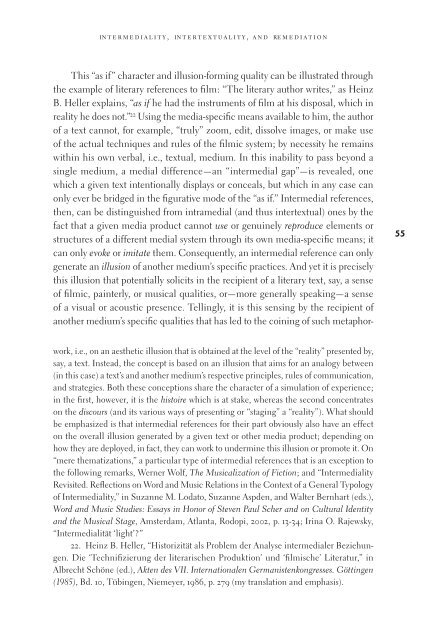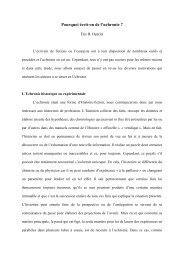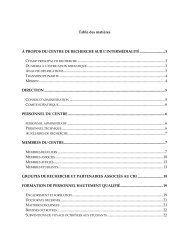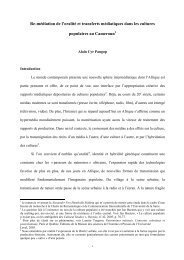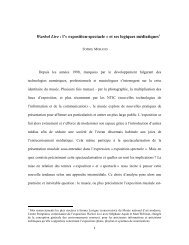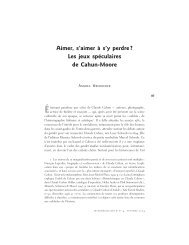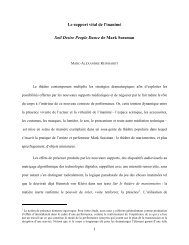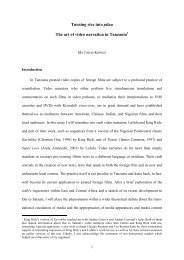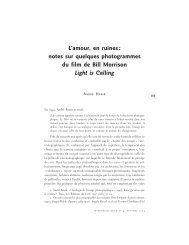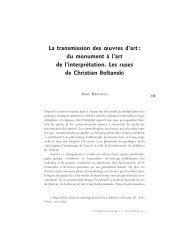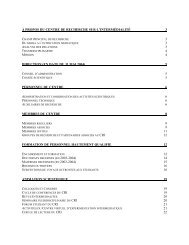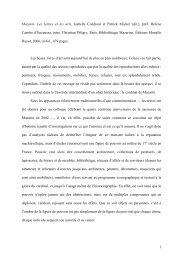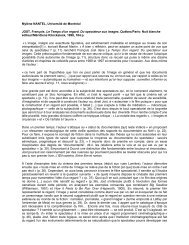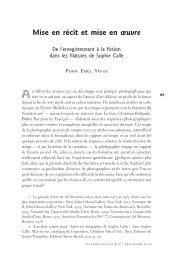Intermediality - Centre de recherche sur l'intermédialité (CRI ...
Intermediality - Centre de recherche sur l'intermédialité (CRI ...
Intermediality - Centre de recherche sur l'intermédialité (CRI ...
Create successful ePaper yourself
Turn your PDF publications into a flip-book with our unique Google optimized e-Paper software.
intermediality, intertextuality, and remediation<br />
This “as if” character and illusion-forming quality can be illustrated through<br />
the example of literary references to fi lm: “The literary author writes,” as Heinz<br />
B. Heller explains, “as if he had the instruments of fi lm at his disposal, which in<br />
reality he does not.” 22 Using the media-specifi c means available to him, the author<br />
of a text cannot, for example, “truly” zoom, edit, dissolve images, or make use<br />
of the actual techniques and rules of the fi lmic system; by necessity he remains<br />
within his own verbal, i.e., textual, medium. In this inability to pass beyond a<br />
single medium, a medial difference—an “intermedial gap”—is revealed, one<br />
which a given text intentionally displays or conceals, but which in any case can<br />
only ever be bridged in the fi gurative mo<strong>de</strong> of the “as if.” Intermedial references,<br />
then, can be distinguished from intramedial (and thus intertextual) ones by the<br />
fact that a given media product cannot use or genuinely reproduce elements or<br />
structures of a different medial system through its own media-specifi c means; it<br />
can only evoke or imitate them. Consequently, an intermedial reference can only<br />
generate an illusion of another medium’s specifi c practices. And yet it is precisely<br />
this illusion that potentially solicits in the recipient of a literary text, say, a sense<br />
of fi lmic, painterly, or musical qualities, or—more generally speaking—a sense<br />
of a visual or acoustic presence. Tellingly, it is this sensing by the recipient of<br />
another medium’s specifi c qualities that has led to the coining of such metaphor-<br />
work, i.e., on an aesthetic illusion that is obtained at the level of the “reality” presented by,<br />
say, a text. Instead, the concept is based on an illusion that aims for an analogy between<br />
(in this case) a text’s and another medium’s respective principles, rules of communication,<br />
and strategies. Both these conceptions share the character of a simulation of experience;<br />
in the fi rst, however, it is the histoire which is at stake, whereas the second concentrates<br />
on the discours (and its various ways of presenting or “staging” a “reality”). What should<br />
be emphasized is that intermedial references for their part obviously also have an effect<br />
on the overall illusion generated by a given text or other media product; <strong>de</strong>pending on<br />
how they are <strong>de</strong>ployed, in fact, they can work to un<strong>de</strong>rmine this illusion or promote it. On<br />
“mere thematizations,” a particular type of intermedial references that is an exception to<br />
the following remarks, Werner Wolf, The Musicalization of Fiction; and “<strong>Intermediality</strong><br />
Revisited. Refl ections on Word and Music Relations in the Context of a General Typology<br />
of <strong>Intermediality</strong>,” in Suzanne M. Lodato, Suzanne Asp<strong>de</strong>n, and Walter Bernhart (eds.),<br />
Word and Music Studies: Essays in Honor of Steven Paul Scher and on Cultural I<strong>de</strong>ntity<br />
and the Musical Stage, Amsterdam, Atlanta, Rodopi, 2002, p. 13-34; Irina O. Rajewsky,<br />
“Intermedialität ‘light’?”<br />
22. Heinz B. Heller, “Historizität als Problem <strong>de</strong>r Analyse intermedialer Beziehungen.<br />
Die ‘Technifi zierung <strong>de</strong>r literarischen Produktion’ und ‘fi lmische’ Literatur,” in<br />
Albrecht Schöne (ed.), Akten <strong>de</strong>s VII. Internationalen Germanistenkongresses. Göttingen<br />
(1985), Bd. 10, Tübingen, Niemeyer, 1986, p. 279 (my translation and emphasis).<br />
55


